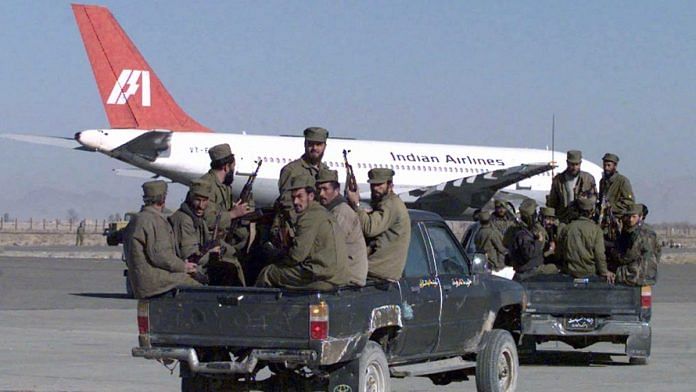New Delhi: A Netflix series based on the 1999 hijacking of Indian Airlines Flight 814 (IC-814) is facing heavy criticism over the names and depictions of the five terrorists who were involved in the eight-day-long ordeal.
The makers of the show IC 814: The Kandahar Hijack have been accused on social media platforms, and also by BJP information cell chief Amit Malviya, of “whitewashing” the religion of the terrorists, through the use of their code names only — ‘Chief’, ‘Doctor’, ‘Burger’, ‘Bhola’ and ‘Shankar’.
As the controversy gained momentum, reports suggested that Netflix India’s content chief Monika Shergill was also summoned by the Ministry of Information and Broadcasting over the six-episode series.
The hijackers of IC-814 were dreaded terrorists, who acquired aliases to hide their Muslim identities. Filmmaker Anubhav Sinha, legitimised their criminal intent, by furthering their non-Muslim names.
Result?
Decades later, people will think Hindus hijacked IC-814.
Left’s…
— Amit Malviya (@amitmalviya) September 1, 2024
The Indian government in January 2000 had identified the men behind the aliases they used to refer to each other inside the plane, and also to the stricken passengers. In a statement on 6 January 2000, then Union home minister L.K. Advani said the hijackers behind the false names were Ibrahim Athar, Shahid Akhtar Sayeed, Sunny Ahmed Qazi, Mistri Zahoor Ibrahim and Shakir. They were all from Pakistan, he said.
Advani said security forces got to know the names of the hijackers after the arrest of four ISI operatives in Mumbai, “who comprised the support cell for the five hijackers of the Indian Airlines Plane”. These four were identified as Mohammed Rehan, Mohammed Iqbal, Yasuf Nepali and Abdul Latif. The first two were Pakistani, the third from Nepal and Latif an Indian.
The government identified Sunny Ahmed Qazi as “Chief”, Shakir as “Doctor”, Mistri Zahoor Ibrahim as “Burger”, Shahid Akhtar Sayed as “Bhola” and Ibrahim Athar as “Shankar”.
Journalist Neelesh Misra, who wrote the book 173 Hours in Captivity on the hijacking, posted on X that “Chief” was the brother of radical Islamist Maulana Masood Azhar, who was in an Indian jail at that time and whose release the five terrorists sought.
“Shankar”
“Bhola”
“Burger”
“Doctor”
and the “Chief”, the brother of then-jailed Masood Azhar himself.
All the hijackers assumed false names. That is how they referred to each other and how the passengers referred to them throughout the hijacking.
— Regards, the author of the… https://t.co/fZgUZiXxPm
— Neelesh Misra (@neeleshmisra) August 31, 2024
IC-814, was scheduled to land in New Delhi after departing from Kathmandu on 24 December, 1999. A total of 191 people were onboard, including crew members and the five terrorists. The plane was hijacked mid-air and then proceeded to land at Amritsar, Lahore, Dubai and finally Kandahar in Afghanistan, where the remaining passengers were set free in exchange for the release of three terrorists in Indian jails — Maulana Masood Azhar, Ahmed Omar Saeed Sheikh and Mushtaq Ahmed Zargar.
Also read: India issues travel advisory for riot-hit UK — ‘avoid areas where protests are underway’
The hijacking operation
According to the government, the hijacking was an operation by the Inter-Services Intelligence (ISI) — Pakistan’s intelligence agency — with assistance from the terrorist organisation Harkut-ul-Ansar.
It took over two months to prepare and plan, with Akthar Sayeed even making a trip to Kathmandu from India on 1 November 1999. Shakir went to Kathmandu a month later on 1 December 1999, about three weeks before the actual hijacking took place.
On 24 December 1999, the five were on IC-814, took over the plane and forced it to fly West. However, the aircraft landed in Amritsar airport in the evening that day to refuel. The plane left for Lahore close to 8 pm.
According to Advani’s statement, the Air Traffic Controller (ATC) in Lahore initially refused permission for the aircraft to land.
“When on its way back from Amritsar, the Chief Hijacker spoke to ATC, Lahore and urged him that the plane had to be refuelled, the ATC Lahore allowed it to land, and provided it fuel,” Advani had said in his statement.
It then proceeded to Dubai, where 27 passengers were released including the body of one who had been fatally stabbed. The plane finally landed in Kandahar, where it remained till the hijackers’ demands were made.
On 31 December 1999, the remaining passengers were released following the prisoner exchange.
(Edited by Tikli Basu)






